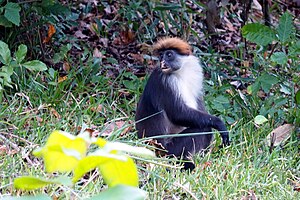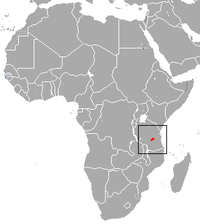Udzungwa colobus monkey
| Udzungwa colobus monkey | ||||||||||||
|---|---|---|---|---|---|---|---|---|---|---|---|---|

Udzungwa colobus monkey ( Piliocolobus gordonorum ) |
||||||||||||
| Systematics | ||||||||||||
|
||||||||||||
| Scientific name | ||||||||||||
| Piliocolobus gordonorum | ||||||||||||
| ( Matschie , 1900) |
The Udzungwa colobus monkey ( Piliocolobus gordonorum ), also known as the red Iringa colobus monkey , is a primate species from the group of colobus monkeys .
features
The fur of these primates is colored black on the back and on the outside of the limbs, the belly is white. The bright red head of hair is striking. The thumb is like regressed in all colobus monkeys, slender of physique. These animals reach a head body length of 46 to 70 centimeters, to which a tail 52 to 80 centimeters long is added.
Distribution and way of life
These primates live exclusively in the Tanzanian Udzungwa Mountains and the adjacent thereto in the East Valley of Kilombero and the gallery forest of Msolwa . The total habitat is less than 5000 km² and fragmented into numerous individual habitats. The Udzungwa colobus monkey inhabits various forest types here at heights between 250 and 2200 m.
The animals are diurnal and mostly stay in the trees. They live in groups of up to 83 animals, which are made up of many males and females as well as young animals. Both sexes establish a hierarchy that comes into play in terms of access to food resources, mutual grooming and mating privilege, among other things.
Their diet consists of young leaves, fruits and shoots. Like all colobus monkeys, they have a multi-chambered stomach for a better breakdown of the difficult to digest plant food.
Hazard and protection
The main threat to the Udzungwa colobus is the destruction and fragmentation of the habitat, e.g. B. through conversion to arable land, logging and charcoal production. Even poaching endangered stocks. These should include several thousand, but probably fewer than the 15,400 previously assumed animals. Due to the limited and highly fragmented area and persistent population decline, the species has been classified as endangered by the IUCN since 2008. About half of the population lives in the Udzungwa Mountains National Park and is relatively safe there.
literature
- Thomas Geissmann : Comparative Primatology. Springer-Verlag, Berlin et al. 2003, ISBN 3-540-43645-6 .
- Don E. Wilson, DeeAnn M. Reeder (Eds.): Mammal Species of the World. A taxonomic and geographic Reference. Johns Hopkins University Press, Baltimore MD 2005, ISBN 0-8018-8221-4 .
Web links
- Photos and information on arkive.org
- Piliocolobus gordonorum in the endangered Red List species the IUCN 2011. Posted by: Struhsaker, T, Butynski, TM & Ehardt, 2008. Accessed February 8, 2012th
